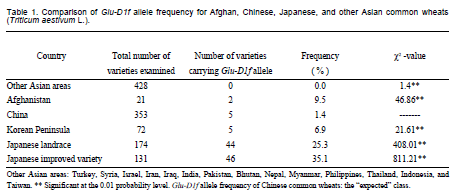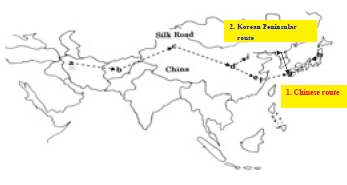Geographical diversity of the glutenin Glu-D1f allele (correlated with noodle-making quality) frequency in Asian common wheat (Triticum aestivum L.) and its transmission routes to Japan in common wheat
Description
It is well known that common wheat(Triticum aestivum L., 2n = 42, AABBDD) was present about 7,000 to 10,000 years ago in the Middle and Near East. It was then transmitted from its origin to Europe, Africa, southern Asia and China. Little is known, however, about the actual route of transmission of common wheat into Japan. The objective of this study was to analyze the distribution of alleles at the Glu-D1 locus throughout Asia, then to determine the route by which common wheat reached Japan, the region most geographically remote from its origin. This study was predominantly on variation in the HMW-glutenin Glu-D1f allele and the factors which affected its distribution in different parts of the world.
In this research, the allelic compositions of the high-molecular-weight (HMW) glutenin subunit from 131 Japanese improved cultivars, as well as 174 Japanese, 353 Chinese, 72 Korean, 150 Turkish, 3 Syrian, 6 Israeli, 4 Iranian, 1 Iraqi, 21 Afghan, 23 Indian, 15 Pakistani, 7 Bhutanese, 66 Nepalese, 1 Myanmar, 1 Filipino, 2 Thai, 3 Indonesian, and 46 Taiwanese landraces of common wheat were investigated. These were examined by sodium dodecyl sulfate-polyacrylamide gel electrophoresis (SDS-PAGE). Gels were made up to 10% (w/v) acrylamide and 0.2% (w/v) bis-acrylamide containing 1.5 M Tris-HCl at pH 8.8 and 0.27% SDS. Concerning the worldwide distribution of the Glu-1 alleles, data on 1,380 published cultivars were available; the frequency of the HMW glutenin alleles was also available for Japanese wheat varieties. These data sets were compared to the results for 1,179 common Asian wheat varieties which were determined in this study. In total, 1,380 published cultivars from 21countries and 1,179 Asian varieties were included in these comparisons. The frequency of the HMW glutenin Glu-D1 alleles in Japanese, Chinese, and other Asian common wheat varieties was analyzed to investigate a possible transmission route for common wheat to Japan. Although the frequency varied among areas, the allele Glu-D1f was present in wheat from northern and southern Japan; Xinjiang, Nanjing, Zhejiang, and Beijing in China; the Korean Peninsula, and Afghanistan. However, a high frequency of the Glu-D1f allele was found predominantly in southern Japan. It was not detected in wheat from any other Asian region (Table 1). This distribution of an adaptively neutral character suggests two specific routes of transmission for common wheat to eastern China, the Korean Peninsula, and Japan. It was introduced from Afghanistan, carried to Xinjiang (in northwest China), Nanjing, Zhejiang (in southeast China), or via the Korean Peninsula, and then to southern Japan along the Silk Road (Fig. 1). It is believed that cultivated common wheat originated in the Middle and Near East and was carried along the Silk Road through China to the Far East and Japan. Japan is the most geographically remote region from the Middle and Near East, the origin of common wheat. During the course of its long journey and its adaptation to diverse local environments, Japanese common wheat has developed a unique composition of glutenin Glu-D1f alleles. In this study, the specific distribution of an adaptively neutral characteristic (the Glu-D1f allele) suggests two transmission routes for common wheat into eastern China and the Far East, the Korean Peninsula, and Japan. The results presented here indicate that the Glu-D1 allele analysis acted as a powerful tool for this investigation of the actual transmission route of common wheat across Asia and into Japan.
The quality of common wheat (Triticum aestivum L.) grain favored in bread and/or noodle making is strongly affected by the components of seed storage protein, particularly HMW glutenin subunits. The HMW glutenin 2.2 subunit controlled by the Glu-D1f allele, which is correlated with good udon noodle making quality, is frequently found in Japanese common wheat varieties and landraces. According to a study of the worldwide distribution of Glu-1 alleles in common wheats, Glu-D1f is rare. The Glu- D1f allele is therefore one of the most important seed storage protein alleles in Japanese common wheat.
Figure, table
-
Table 1.
Comparison of Glu-D1f allele frequency for Afghan, Chinese, Japanese, and other Asian common wheats (Triticum aestivum L.). -
Fig. 1.
Possible transmission routes for common wheat (Triticum aestivum L.) into Japan.
a: Middle and Near East (the origin of common wheat ); b: Afghanistan; c: Xinjiang; d: Xian; e: Jiangsu; f: Zhejiang; g: Southern Japan; h: Northern Japan; i: Beijing
- Affiliation
-
Japan International Research Center for Agricultural Sciences Food Science and Technology Division
- Classification
-
Technical A
- Term of research
-
FY2002~2004(FY2002~2005)
- Responsible researcher
-
NAKAMURA Hiro ( Food Science and Technology Division )
- ほか
- Publication, etc.
-
Hiro NAKAMURA (2002):Frequency of the high-molecular-weight glutenin allele in Asian hexaploid wheat (Triticum aestivum L.) and the transmission route through which the wheat may have reached Japan, the most geographically remote region of wheat production in the world. J. Agric. Food. Chem., 50 (23), 6891-6894.
Hiro NAKAMURA (2002):The geographical diversity of the frequency of the Glu-D1f allele in Asian common wheat, and the transmission route through which the wheat may have reached Japan. Aust.J.Agric.Res., 53 (11), 1265-1269.
NAKAMURA, H. (2003) Agriculture and horticulture, 78 (3), 347-350
Hiro NAKAMURA (2004):Specific glutenin allele frequencies of Japanese common wheat cultivars compared with the worldwide distribution of Glu-1alleles.Annual Wheat News Letter, 50, 76-79.
- Japanese PDF
-
2004_13_A3_ja.pdf604.71 KB


